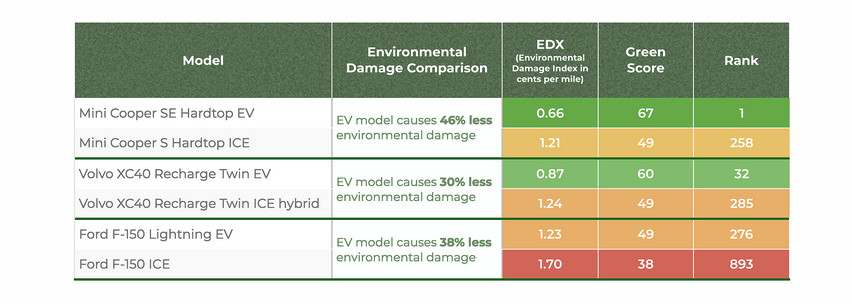Lighter EVs are greenest, thirsty gas trucks are meanest

When considering the overall environmental impact of new cars and trucks, it’s important to look not only at the powertrain, but also the curb weight, according to a new analysis from the American Council for an Energy-Efficient Economy (ACEEE).
The group annually releases a “Greenest List” of the 12 vehicles estimated to do the least damage to the environment, as determined by a holistic look at tailpipe emissions, manufacturing, and disposal, as well as emissions related to production of electricity or fuel. It also releases a “Meanest List” of the 12 worst environmental offenders.
The 2023 “Greenest List” was entirely made up of small EVs, hybrids, and plug-in hybrids—with EVs in the top five slots. The Mini Cooper SE was named greenest of the green, followed by the Nissan Leaf, Mazda MX-30 EV, Toyota bZ4X, and Subaru Solterra. You can browse the full list at the ACEEE GreenerCars website.

Environmental damage comparison from ACEEE 2023
The ACEEE also compiled a “Greener List” of vehicles estimated to have a low environmental impact, but that didn’t make the “Greenest List.” This contingent was led by the Honda Accord Hybrid, with the Mitsubishi Mirage, Lexus ES 300h hybrid, Honda CR-V Hybrid, and Toyota RAV4 Hybrid rounding out the top five.
Of note is that the redesigned 2023 Toyota Prius was not included on either list. It was named greenest car of 2022 by the organization, but the redesigned version arrived too late to be included on the 2023 list. The Hyundai Ioniq Plug-In Hybrid was runner up to the Prius in 2022, but Hyundai has since ended production of this model.
The “Meanest List” consisted mostly of big pickup trucks and SUVs, with the Ram 1500 TRX rated worst for the environment, followed by the Ford F-150 Raptor R, Cadillac Escalade V, Dodge Durango SRT, and Jeep Wrangler Unlimited.

Environmental damage comparison from ACEEE 2023
Analysts also did direct comparisons for vehicles available with both all-electric and internal-combustion powertrains, including the Mini Cooper Hardtop, Ford F-150, and Volvo XC40, with all-electric versions expected to cause 46%, 30%, and 38% less environmental damage, respectively.
The gasoline Mini Cooper SE also had a lower anticipated environmental impact per mile than the Ford F-150 Lightning electric truck, authors noted—again underscoring the importance of weight.
Lighter weight has long been the favored path toward improving efficiency and boosting EV range, but it’s not cheap. A 2020 report predicted that, because of the expensive materials needed to dramatically reduce weight, improvements to battery energy density might be a better bet. Lighter cars that carry more people might be the ultimate solution, but this runs counter to vehicle-owner habits.
Thinking about the overall efficiency of EVs is important as more of them hit the road. In addition to publishing its annual “Greenest” and “Meanest” lists, the ACEEE has also argued in the past that EV efficiency and upstream emissions are a lost opportunity in U.S. vehicle standards, citing potential emissions from the electricity grid as an area of concern.